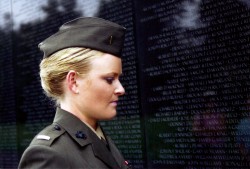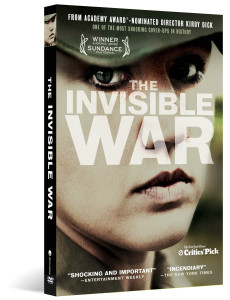CASE STUDY: THE INVISIBLE WAR

Documentary Feature
Director: Kirby Dick
Producers: Amy Ziering, Tanner Barklow
Budget: $850,000
Financing: Television sales, non-profit donations, grants
Production: February 2010 – December 2011
Shooting Format: Canon 5D, Sony Z1
Screening Format: HDCAM, DCP, Blu-Ray
World Premiere: 2012 Sundance Film Festival
Awards: 2012 Sundance Film Festival: Winner Audience Award – Best Documentary
2013 Academy Awards: Nominated – Best Documentary Feature
2013 Film Independent Spirit Awards: Nominated – Best Documentary
2012 National Board of Review: Top 5 Documentaries of the Year
2012 International Documentary Association: Nominated – Best Feature Documentary
2012 Gotham Independent Film Awards – Nominated – Audience Award
2012 Human Rights Watch Film Festival
: Winner Nestor Almendros Award
2012 Dallas International Film Festival
: Winner Silver Heart Award
2012 Seattle International Film Festival
: Winner Best Documentary
2012 Provincetown International Film Festival: Winner Best Documentary
2012 International Conference on Violence, Abuse and Trauma: Distinguished Service Awards for Excellence in the Medium of Film
2012 Peace Over Violence 41st Annual Humanitarian Awards: Humanitarian Award Media Advocacy
2012 DocuWest Documentary Film Festival: “Best of Fest”
Website: http://invisiblewarmovie.com
Official Synopsis
From Oscar and Emmy®-nominated filmmakers Kirby Dick (This Film Is Not Yet Rated; Twist of Faith) and Amy Ziering comes The Invisible War, a groundbreaking investigative documentary about one of America’s most shameful and best kept secrets: the epidemic of rape within the U.S. military. The film paints a startling picture of the extent of the problem today – a female soldier in combat zones is more likely to be raped by a fellow soldier than killed by enemy fire. The Department of Defense estimates there were a staggering 19,000 violent sex crimes in the military in 2010. The Invisible War exposes the epidemic, breaking open one of the most under-reported stories of our generation, to the nation and the world.
Development and Financing
Upon first conducting research on the issue of sexual assault in the military, the filmmakers were surprised to discover that despite the high estimates of sex crimes each year, there was a gaping absence of media coverage on the rampant problem. Dick found that not only were these statistics underreported, but also that there was little awareness of the damaging psychological effects on women (women who have been raped in the military have higher PTSD rate than men in combat). In addition to the lack of press on the issue, there were hardly any books or other types of publications that addressed the subject.
Given the gravity of the concealed epidemic and the potential to raise the issue in Congress, the filmmakers decided to make the film with or without outside funding. Dick explains, “The real hurdle is to find a film that I’m convinced will be successful. That’s actually more difficult than finding the money.” With a small grant from the Funding Exchange that carried over from his last film (approximately $20K), a loan from producer Amy Ziering (which was paid back), and his own resources and staff at his production company, the two began the process of finding subjects. They methodically conducted a search by reaching out to attorneys, therapists and victim advocates, and also investigated support groups online using Facebook and other networks.

Once they developed a list, Ziering handled the outreach and developed a rapport with over 100 subjects via lengthy in-depth conversations over the phone. They then shot pre-interviews; Ziering conducted the interviews and Dick shot and asked follow-up questions. Once the project was underway and they had some footage to present to potential funders, it was much easier to acquire financing.
Executive producer Teddy Leifer of Rise Films also acted as a sales agent and acquired a $50K grant from Channel 4 halfway through production. ITVS also contributed a development grant and, later in the process, provided a larger production grant ($250K in total). In September 2011, the filmmakers also obtained several private donations from their participation in Good Pitch, a partnership between BRITDOC and the Sundance Institute Documentary Fund that enables filmmakers to pitch their documentaries and associated social action campaigns to philanthropists, foundations and other organizations.
Production
Once they narrowed down their subjects, Dick and Ziering set out on a ten-day cross-country trip in October 2010, beginning in New York and ending in Los Angeles. Dick recalls, “By compressing that many interviews into such a short amount of time, it emotionally cemented for us what the film was going to be about.” They interviewed Kori Cioca on this trip, a female veteran of the Coast Guard, who ended up being one of the primary subjects in the film. Because most of the subjects were women, it proved helpful to have a female producer on the project who could empathize with the victims and eventually gain their trust.
The fragility of the subjects was one of the biggest challenges during production since they would often cancel last minute, or in some cases, decide to withdraw from the project entirely. One of the reasons for the non-disclosure of instances of assault in the military was that most women do not report due to the repercussions of testifying against their superiors. Despite these challenges, in the end, the participants were happy that they shared their experiences; not only would their disclosure help others in the future, but it also served as a form of therapy and enabled their spouses to better understand what they were going through after seeing their stories portrayed in the larger context of the film.
It was difficult for the filmmakers to acquire the consent of Pentagon officials in the Sexual Assault Prevention and Response Office (SAPRO). However, once they did agree to participate, they provided the filmmakers with a wide window into their policies. This was in part due to the officials’ lack of knowledge of the prevalence of rape in military compounds; there was a surprising discord between what the SAPRO officials were aware of and what the filmmakers knew.
Dick discovered through interviews with the victims that the real heart of the problem was the inadequacy of the military criminal justice system, where cases often were closed without punishing the offenders and therefore never were exposed to the public. Obtaining interviews with military court officials or investigators was equally challenging, since most were reluctant to criticize the military even though they knew these crimes were being covered up.
Dick began editing in June 2011 while still shooting, which allowed him to discern which material he still needed to convey the whole story. At that point, he put all other projects aside and focused solely on the documentary. One of the primary difficulties was to make a film both for the general audience and policy makers, since some aspects of the story lend themselves better to one group than the other. He licensed some stock footage, but was able to use most of the archival clips under fair use, including the news footage and videos produced by the Department of Defense, which are technically in the public domain.
Festival Preparation and Strategy
In the June 2011, the team set the goal to complete the film in time to submit to Sundance, surmising that a release in the spring of 2012 would be the best time to affect politics on the issue. He shot interviews all the way through December 2011, knowing that he could complete post-production and provide deliverables quickly, since he was experienced with the process and had a network of post professionals that he had worked with in the past.
In preparation for Sundance, Dick and Ziering hired Nancy Willen of Acme PR as the publicist and Jonathan Dana and Orly Ravid of The Film Collaborative as the producer’s reps. They were able to raise $40K for the festival, which primarily came from female private donors, who were huge supporters of the issue and film. Normally they do not spend this much on a premiere, but he knew that in this case, it was worth the investment because “the more this exploded out of Sundance, the greater the impact was going to be in Washington, DC.” Screenings left audience members emotionally stunned, and the film ended up winning the Audience Award for Best Documentary, generating press that helped forward the social action campaign.

The Sale
As part of the terms of the ITVS grant, PBS has domestic television rights and will air the film in 2013. Channel 4 ended up releasing their ownership of UK television rights due to a shift in programming. Negotiations began with Cinedigm at Sundance and they bought US theatrical rights six weeks later, which included a deal with New Video (a partner of Cinedigm) for North American DVD, VOD and digital rights. Cinedigm provided a small advance (undisclosed) and agreed to a profit share on the backend.
Ro*co Films bought foreign and educational rights and have sold to 7-8 territories so far. Leifer sold to France and the UK and Dick sold to the CBC in Canada.
The Release
Dick and Ziering held a screening on Capitol Hill in Washington, DC a month after Sundance, which sparked conversation among members of Congress. The filmmakers organized 30-40 private screenings for policymakers and devoted much of their time reaching out to politicians, advocacy organizations, journalists and military personnel. They already had several political connections, including Senator Barbara Boxer, the mother of executive producer Nicole Boxer. The private screenings created a strong word of mouth campaign, which led in part to Secretary of Defense Leon Panetta seeing the film.
Partly because he was so moved by the film, Panetta held a press conference where he announced changes to military policy. The new policy no longer allows unit commanders to make the decision as to whether rape charges should be investigated and prosecuted, moving the judgment higher up in the chain of command. Prior to the theatrical release, the filmmakers also founded Invisible No More, a non-partisan coalition that seeks to raise public awareness, effect political and cultural change, and serve as a means of healing for survivors of military sexual assault (description taken from the website).
Cinedigm scheduled the theatrical release for June 22, 2012 and hired Los Angeles-based publicist Nancy Willen, New York-based publicist Susan Norget and Washington D.C. based publicist Jamie Schor to organize the publicity campaign. The subjects of the documentary made several television appearances on talk shows, including The View. Although the film only reached a total domestic box office of $60,000, the film has had an immense impact on policymakers and has raised public awareness. It also scored the highest review rating on Rotten Tomatoes so far in 2012. The soft box office figure is mostly due to the depressing subject matter, which has deterred people from making it to the theaters.
The Invisible War has played to large audiences at several film festivals, including New York, Toronto, San Francisco, Los Angeles and Seattle. Film Sprout is handling non-theatrical, community screenings that include panels and Q&As related to the social issue. Half of these screenings have taken place on military bases, which are beginning to incorporate screenings of the film into their training programs.

Advice from the Director
Director Kirby Dick advises, “Screen your films in advance to small audiences and get audience reaction through the editing process. You are so familiar with the material and close to the subjects that you lose the perspective of an audience member.” Ranging from overall themes to small details, “there are always dozens of surprises that come up – you think something is working one way and it’s working completely another way…It is also a way of polishing the film from multiple perspectives” to prepare the film for submission to festivals.